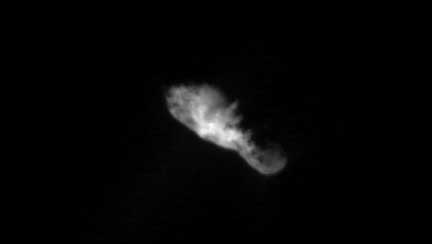19P/Borrelly

Discovery
Comet 19P/Borrelly was discovered by Alphonse Louis Nicolas Borrelly on Dec. 28, 1904, in Marseille, France.
Overview
With a shape resembling a chicken leg, the nucleus of comet 19P/Borrelly is approximately 5 miles (8 kilometers) long. The nucleus is inside a much larger cloud of gas and dust known as the "coma."
Borrelly follows an elliptical orbit around the Sun, looping from inside the orbit of Mars to outside the orbit of Jupiter and back again. It is a "Jupiter-family comet," with an orbital period of fewer than 20 years that has been significantly modified by the gravity of Jupiter. (Astronomers have discovered hundreds of Jupiter family comets.)
It takes 6.9 years for Borrelly to orbit the Sun once. The comet last reached perihelion, its closest approach to the Sun, in 2015.
NASA's Deep Space 1 spacecraft encountered comet Borrelly on Sept. 22, 2001. Flying by at a speed of 10 miles (16.6 kilometers) per second (more than 37,000 mph, or almost 60,000 kph), Deep Space 1 traveled within 1,349 miles (2,171 kilometers) of the comet's nucleus. The spacecraft captured the best pictures of any comet's nucleus at the time and collected other valuable scientific data as well.
Deep Space 1, which was launched in 1998, was designed to test high-risk, advanced technologies on an operational interplanetary mission. Technologies proven by this mission have been used to benefit almost all deep-space missions since then. One of the most exotic technologies, ion propulsion, was essential for the success of NASA's Dawn mission to Vesta and Ceres.
How This Comet Got Its Name
Comets are usually named for their discoverer(s) or for the name of the observatory or telescope used in the discovery. Since Alphonse Borrelly discovered this comet, it is named after him. The letter "P" indicates that 19P/Borrelly is a "periodic" comet, meaning it has an orbital period of less than 200 years.




